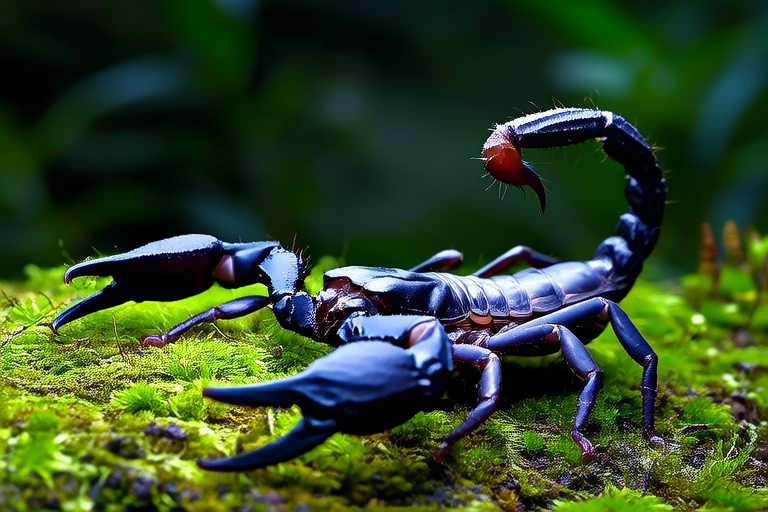From Jungle to Home: How to Care for a Heterometrus Spinifer Pet Scorpion
Welcome to the fascinating world of scorpions! Among the diverse species of these ancient arachnids, the Heterometrus Spinifer stands out as a popular choice for pet enthusiasts. Known for its impressive size and unique appearance, this species offers a captivating experience for both novice and seasoned arachnid keepers. In this comprehensive guide, we will explore everything you need to know about caring for a Heterometrus Spinifer scorpion, from setting up the perfect habitat to understanding their dietary needs and health concerns.
Introduction: The Unique Characteristics of Heterometrus Spinifer
The Heterometrus Spinifer, commonly known as the Indian Forest Scorpion or Indian Red Forest Scorpion, is a species native to India and Southeast Asia. This medium-sized scorpion can grow up to 10 centimeters in length, making it one of the largest scorpion species suitable for captivity. Its distinct reddish-brown coloration and the prominent spines on its pedipalps (claws) give it a striking appearance. Despite their intimidating looks, these scorpions are generally docile and can make rewarding pets when properly cared for.
Setting Up the Perfect Habitat
Enclosure Size and Type
Adequate space is crucial for the well-being of your Heterometrus Spinifer. A 10-gallon tank is ideal for a single adult, providing enough room for them to move around comfortably. Glass tanks or acrylic enclosures work well, ensuring good visibility while maintaining optimal environmental conditions. Ensure the enclosure has a secure lid with ventilation holes to prevent escape attempts.
Substrate and Decorations
The substrate should mimic the natural environment of the scorpion, promoting a healthy burrowing behavior. A mix of coconut fiber and play sand works best, creating a deep layer that allows for digging and burrowing. Avoid using calcium sand or other fine substrates that could cause respiratory issues. Adding branches, cork bark, and smooth rocks provides essential hiding spots and climbing structures, mimicking the complexity of their natural habitat.
Temperature and Humidity Levels
Heterometrus Spinifer thrives in tropical climates, requiring specific temperature and humidity conditions. Maintain daytime temperatures between 80°F and 90°F (27°C to 32°C) with a slight drop at night to 75°F to 80°F (24°C to 27°C). Use a reliable thermometer to monitor these levels accurately. Humidity should be kept between 60% and 80%, achieved through regular misting and the use of a hygrometer. Ensure proper drainage by placing a shallow water dish filled with dechlorinated water at one end of the enclosure.
Hiding Spots and Environmental Enrichment
Providing multiple hiding spots is vital for the psychological well-being of your scorpion. These shelters should be dark, snug, and positioned at different heights within the enclosure. Cork bark tubes, half logs, and ceramic hides are excellent choices. Additionally, incorporating live plants or artificial foliage adds aesthetic appeal and enhances the overall environment, stimulating natural behaviors.
Dietary Needs and Feeding Schedules
Food Preferences and Nutritional Requirements
Heterometrus Spinifer is primarily carnivorous, feeding on insects such as crickets, mealworms, and dubia roaches. Ensure the prey items are appropriately sized, no larger than half the width of the scorpion’s body. Offering variety in their diet ensures they receive all necessary nutrients. Feed your scorpion every 7 to 10 days, adjusting frequency based on their appetite and activity level.
Gut Loading and Dusting Prey Items
To maximize nutritional value, gut load feeder insects by offering them a nutritious diet of fruits, vegetables, and commercial insect food before feeding them to your scorpion. Additionally, dusting prey items with calcium powder and multivitamin supplements once a week helps maintain strong exoskeletons and overall health.
Handling Tips for Owners
While Heterometrus Spinifer are relatively docile, handling should always be approached with caution. Use long-handled tweezers or forceps to gently lift and transfer your scorpion, minimizing direct contact. Always wash your hands before and after handling to prevent the spread of bacteria. Never handle your scorpion immediately after feeding, as this increases the risk of accidental injury.
Common Health Issues and Signs of Distress
Recognizing Illnesses and Injuries
Regular observation is key to identifying potential health issues early. Common signs of distress include lethargy, refusal to eat, abnormal behavior, and changes in coloration. If you notice any of these symptoms, consult a veterinarian specializing in exotic animals for proper diagnosis and treatment.
Maintaining Cleanliness and Hygiene
Keeping the enclosure clean is essential for preventing infections and diseases. Remove uneaten prey and waste daily, performing a thorough cleaning of the tank and substrate every two weeks. Disinfect all equipment and decorations with a reptile-safe cleaner, rinsing thoroughly before reuse.
Bonding with Your Scorpion
Building a bond with your Heterometrus Spinifer may take time but is incredibly rewarding. Spend quality time observing their natural behaviors, respecting their need for privacy and security. Over time, your scorpion may become more comfortable with your presence, recognizing you as a non-threatening figure in their environment.
Resources for Further Learning
For those eager to learn more about Heterometrus Spinifer and other scorpion species, numerous books, articles, and online forums provide valuable information. Joining local reptile clubs or online communities allows you to connect with fellow enthusiasts, sharing experiences and insights. Always stay informed about the latest advancements in scorpion care to ensure your pet lives a long and healthy life.
